Mineral Spirits vs Paint Thinner (Differences & Uses)
Wondering if you should use mineral spirits or paint thinner? I’ll break down the differences between them in this side-by-side comparison.
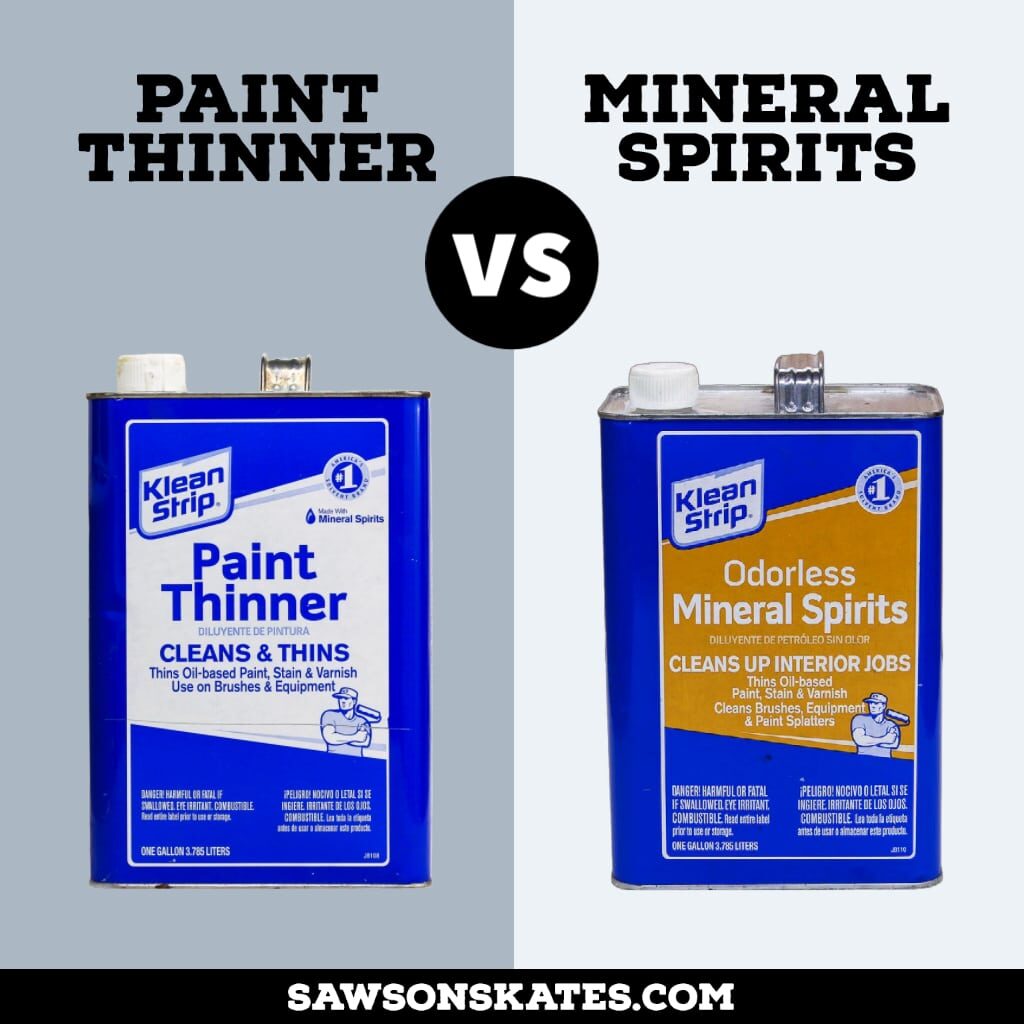
Mineral spirits and paint thinner are both solvents. They share some similarities, but there are some important distinctions between them. In this article, I’ll compare the differences, their uses, the pros and cons, and which to choose for your project.
This tutorial contains affiliate links to supplies and tools. Purchases made using these links help support the Saws on Skates website and allows me to share more projects and tips with you. There is no cost to you for using these links. Visit my site policies for more information.
Table of Contents
- What is Mineral Spirits?
- Mineral Spirits Uses
- What Can You Substitute for Mineral Spirits?
- Pros and Cons of Mineral Spirits
- What is Paint Thinner?
- Paint Thinner Uses
- What Can You Substitute for Paint Thinner?
- Pros and Cons of Paint Thinner
- What are the Differences Between Mineral Spirits and Paint Thinner?
- Which Should You Buy Paint Thinner or Mineral Spirits?
- Comparison Chart
- Frequently Asked Questions
What is Mineral Spirits?
Mineral spirits is a solvent manufactured from petroleum, a fossil fuel that lies beneath the earth’s surface. It’s refined to create gasoline, kerosene, and other products such as mineral spirits.
What is a solvent?
A solvent is a substance that can be used to dissolve other substances.
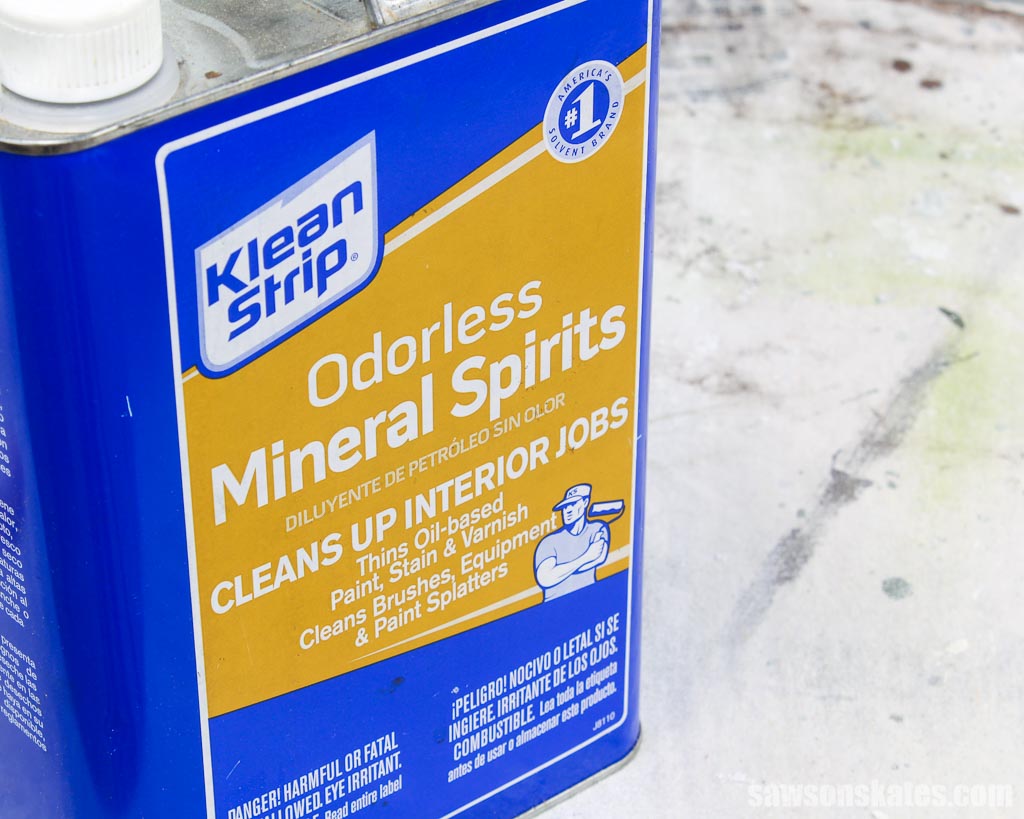
Mineral spirits, a chemical developed in the early 1900s, is also known as white spirit, artist’s white spirit, and mineral turpentine.
Mineral spirits is commonly used as a component in oil-based paints and coatings, such as polyurethane.
Related: Polycrylic vs Polyurethane (Are They The Same?)
Mineral spirits is flammable and should be kept away from heat sources and open flames. It also emits strong, toxic fumes that can cause headaches and irritation, so work in a ventilated area with plenty of fresh air.
An odor-free version of mineral spirits is available called odorless mineral spirits, which, as the name suggests, doesn’t have a strong odor. It has been further refined to remove impurities, making it a better choice for indoor projects.
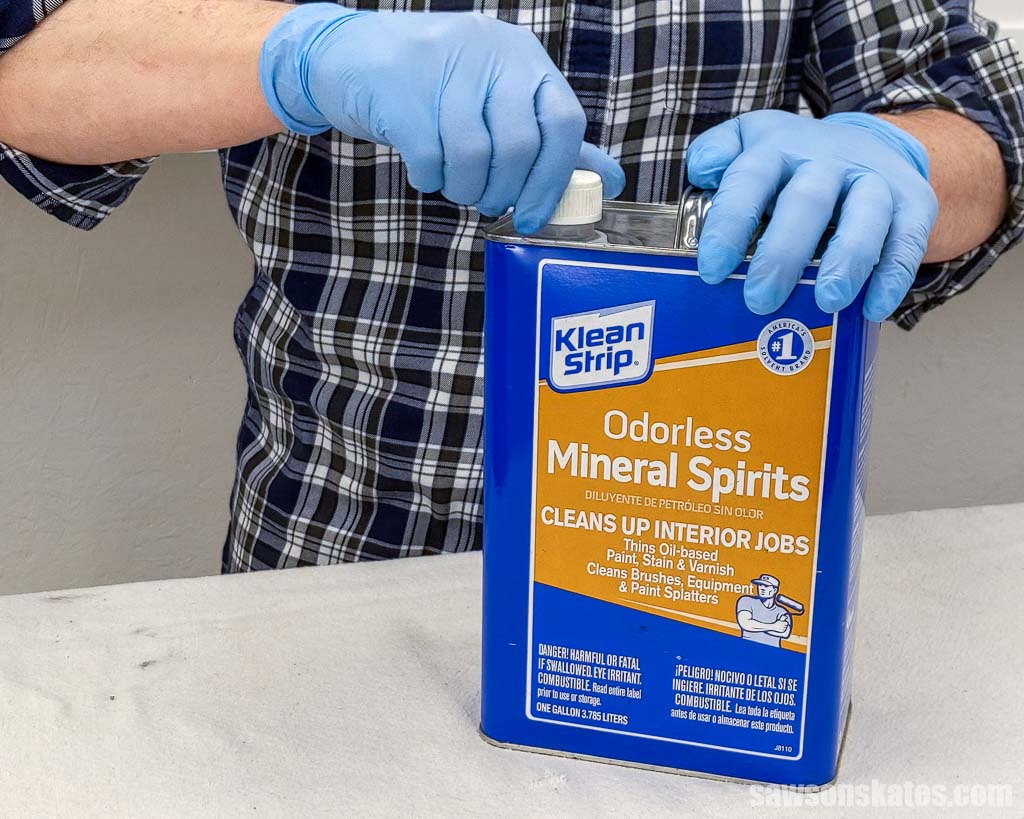
Mineral Spirits Uses
Mineral spirits is a powerful solvent that may be used for various applications. However, you should always wear gloves because it’s harsh and can cause irritation or burning on the skin.
💡 TIP: Make sure to test it on an inconspicuous spot to be sure it won’t damage the surface.
Thinning Oil-Based Paints, Stains, and Finishes
Mineral spirits is commonly used to thin the consistency of oil-based paints, stains, and top coats, allowing them to spread more easily and evenly.
Cleaning Paint Brushes and Other Painting Equipment
After applying your oil-based paints, stains, and top coats, mineral spirits can be used to clean your brushes and other equipment.
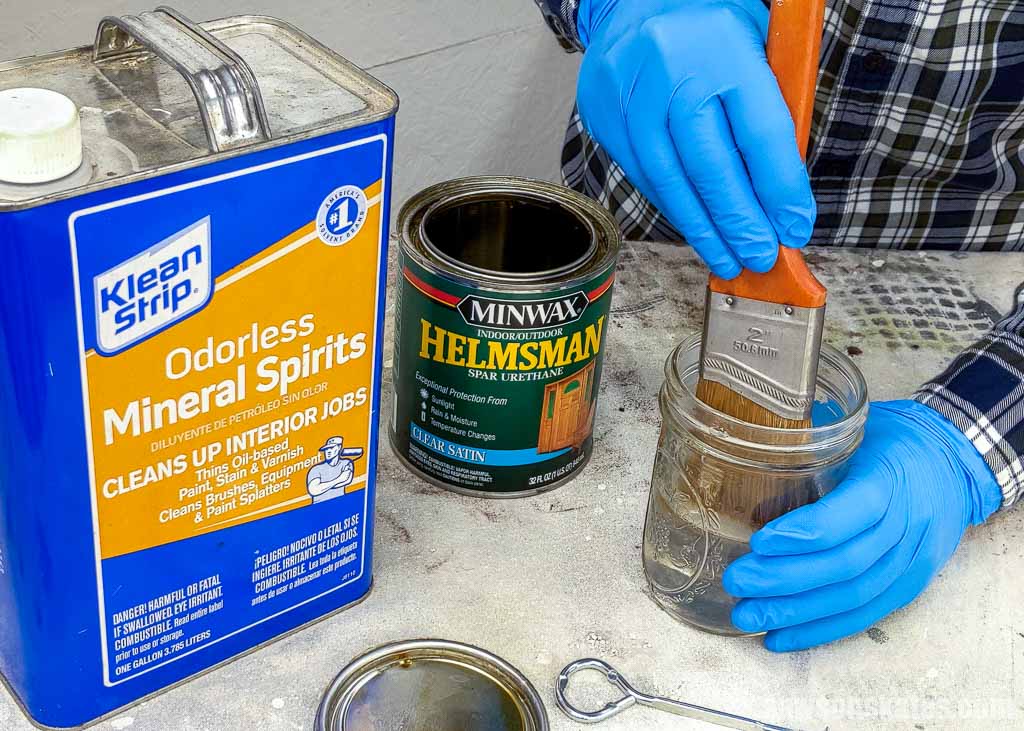
Cleaning Wood Surfaces
Mineral spirits doesn’t dissolve cured finishes, such as polyurethane, lacquer, or shellac, making it a good choice for cleaning wood surfaces like furniture and floors. To be safe, always test it on a hidden area first.
⚠️ IMPORTANT: Mineral spirits should not be used on wood that has a wax finish.
Degreasing Metal Surfaces
Mineral spirits can be used to remove petroleum-based oils and lubricants from metal components and machinery.
Removes Adhesives and Pine Sap
Mineral spirits may be used to remove sticky substances such as adhesives from price tags and pine sap.
What Can You Use as a Substitute for Mineral Spirits?
If you don’t have mineral spirits on hand, there are several alternatives you may use instead.
Brushes or other painting equipment soaked in oil-based paints, stains, or top coats, may be cleaned with paint thinner or turpentine instead of mineral spirits.
To remove sticky substances such as pine tar or price tags, you can use denatured alcohol or acetone instead of mineral spirits.
Related: Denatured Alcohol vs Mineral Spirits (Differences + Uses)
Pros and Cons of Mineral Spirits
Pros
- It’s a strong solvent that may be used to thin and clean oil-based paints, stains, and coatings.
- Odorless mineral spirits is available.
- It removes sticky adhesives and pine sap.
Cons
- It’s flammable and shouldn’t be used near heat sources or flames.
- It has toxic fumes that can cause headaches and irritation.
What is Paint Thinner?
The answer to the question “what is paint thinner?” is a bit confusing, so bear with me.
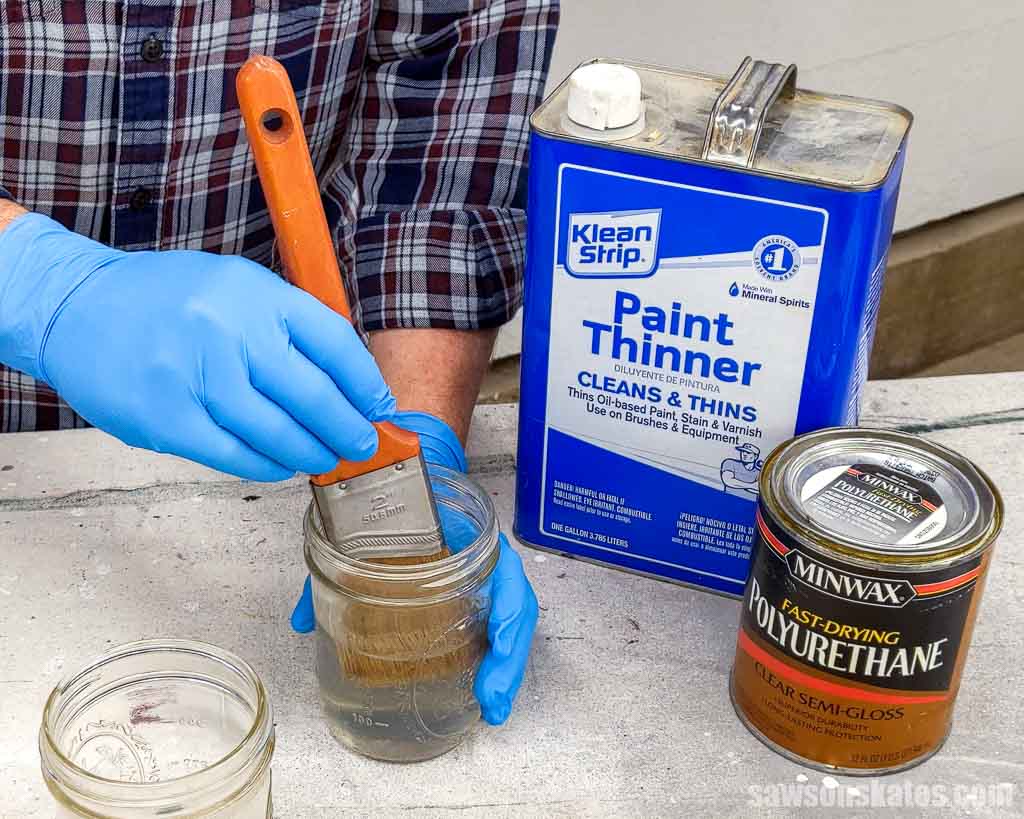
Paint thinner is a generic term for any solvent used to thin oil-based paints or clean up after their use.
But here’s the confusing part, the product on store shelves marketed as “paint thinner” is frequently a less refined type of mineral spirits. Sometimes “made with mineral spirits” is even noted on the container.
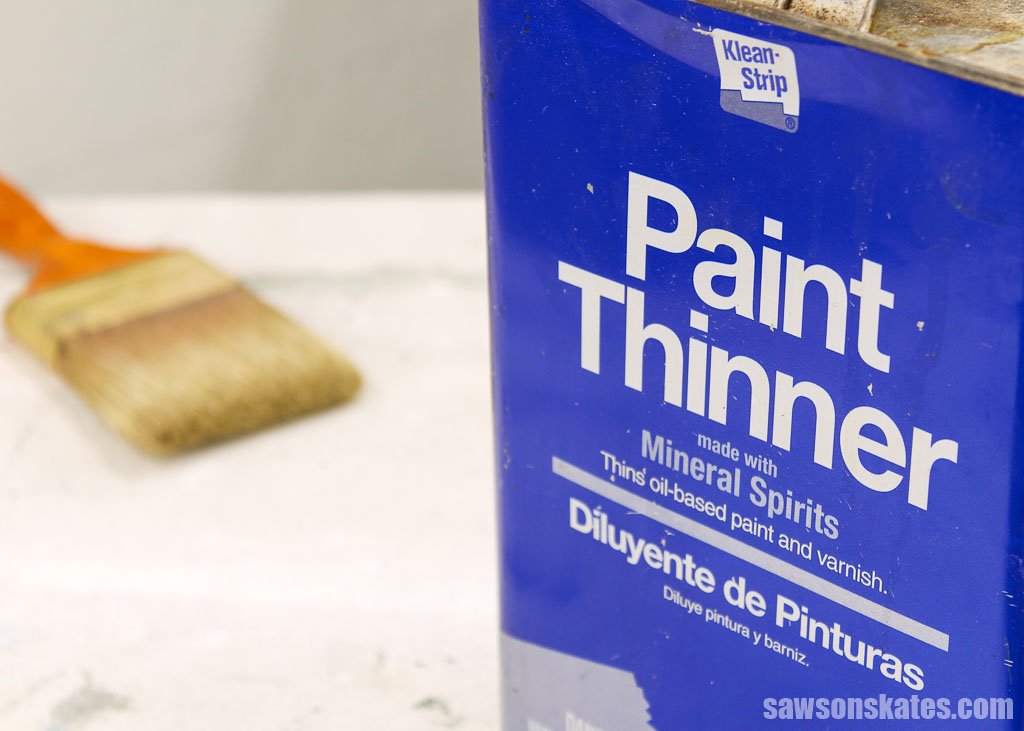
Solvents sometimes referred to as paint thinner includes acetone, turpentine, and naptha.
Related: Mineral Spirits vs Acetone (Differences + Which to Use)
So, to recap, paint thinner is a less refined type of mineral spirits, or it can be a general category of solvents used to thin oil-based paints.
📝 NOTE: To avoid confusion, we’ll only focus on mineral spirits-based paint thinner for the remainder of this article.
Because paint thinner is less refined than mineral spirits, the drawback is it contains impurities and more volatile organic compounds.
Volatile organic compounds (VOCs) are chemicals that readily convert to vapors or gases at room temperature. VOCs are toxic and, when released into the air, can be harmful to your health.
VOCs are associated with nausea, dizziness, and eye, nose, and throat irritation. Long-term exposure to VOCs can cause liver and kidney damage as well as damage to the central nervous system.
Paint thinner is also flammable, so it should be used with caution.
The advantage of paint thinner is it’s usually cheaper than mineral spirits.
Now that we’ve answered the question “what is paint thinner,” let’s move on to its uses.
Uses for Paint Thinner
Paint thinner may be used to thin oil-based paint, stains, and finishes, as well as clean brushes and other equipment after their use. When using paint thinner, you should protect your hands with gloves and work in a well-ventilated area, away from any heat sources.
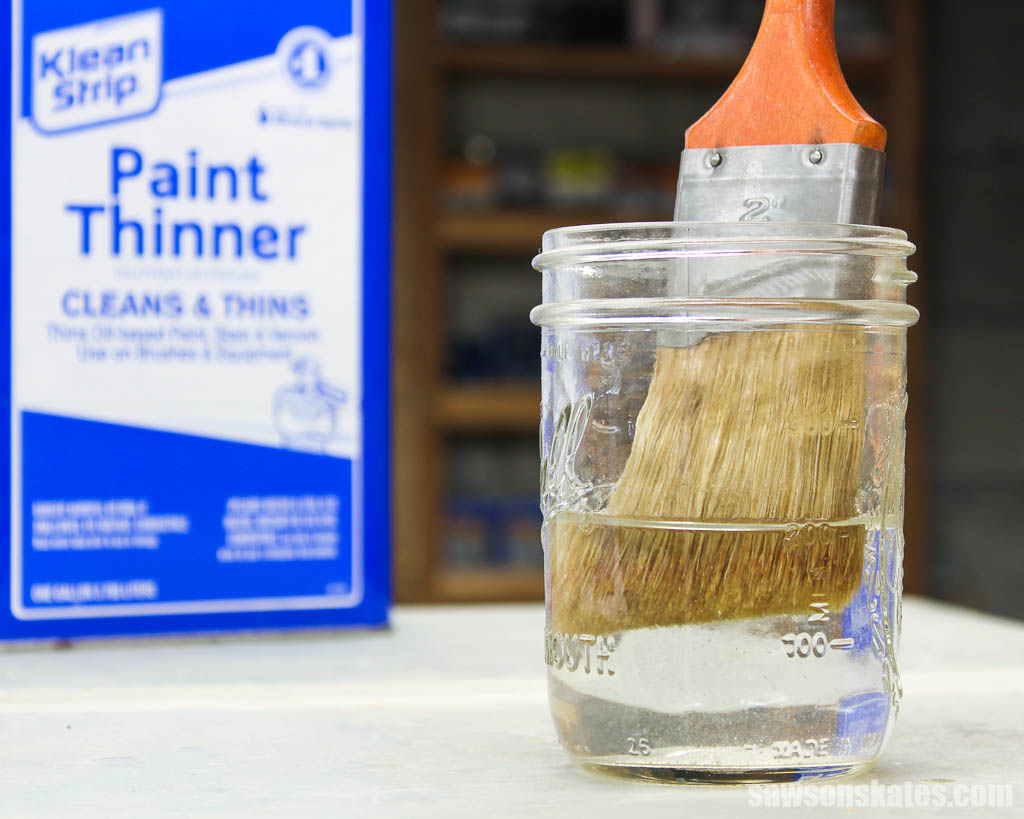
It can also be used to remove sticky residues such as labels and price tags or dissolve grease and oil from metal surfaces.
Paint thinner is not compatible with water-based products, such as latex paint, so it should not be used to thin or clean up after water-based coatings.
Paint thinner should not be used as a substitute for lacquer thinner, which is a solvent used to dissolve and remove lacquer-based paints and finishes.
Pros and Cons of Paint Thinner
Pros
- It’s a powerful solvent that may be used to thin oil-based paints, stains, finishes, and varnish.
- It’s often cheaper than mineral spirits.
Cons
- It’s flammable.
- It contains VOCs that can be harmful to your health.
- It’s not compatible with water-based products.
What Can You Substitute for Paint Thinner?
Paint thinner can often be substituted with mineral spirits, acetone, turpentine, or naptha.
Paint thinner and mineral spirits may be used interchangeably. Acetone is a solvent that can be used to remove sticky residues from surfaces.
Turpentine and naptha are also effective solvents for thinning oil-based paint and removing residues.
What are the Differences Between Mineral Spirits and Paint Thinner?
Paint thinner and mineral spirits are both powerful solvents that have a variety of uses. They can be used to thin oil-based paints, stains, finishes, and varnish, as well as clean up after their use.
They are also flammable, so use them with caution.
Toxicity
Toxicity is one of the main differences between mineral spirits and paint thinner.
Mineral spirits is more refined than paint thinner, which reduces the amount of toxic volatile organic compounds (VOCs) emitted into the air. Regular mineral spirits has a strong odor, while odorless mineral spirits have been refined further to eliminate this unpleasant smell. In contrast, paint thinner is less refined and therefore contains more toxic VOCs than either mineral spirits or odorless mineral spirits.
Odor
Besides the difference in toxicity, another significant distinction between these solvents is their odor. Mineral spirits has a strong, pungent odor that can be overwhelming, while paint thinner has an even stronger smell. However, odorless mineral spirits has no smell at all.
Cost
The cost of mineral spirits and paint thinner can vary depending on the brand and where you purchase them. In general, mineral spirits is more expensive than paint thinner because it’s more refined. A gallon of mineral spirits typically goes for $10, while an odorless version could cost up to $15 compared to just $8 for one gallon of paint thinner.
Which Should You Buy Paint Thinner or Mineral Spirits?
Now that you know the key differences between paint thinner and mineral spirits, you can decide which is the better option for your needs.
If you’re looking for a powerful solvent to thin oil-based paints, stains, or finishes, then either paint thinner or mineral spirits will work. However, if you’re concerned about toxicity, then you may want to choose mineral spirits over paint thinner.
Odor is another factor to consider when choosing between these two solvents. If you’re sensitive to strong smells, you should opt for odorless mineral spirits. Otherwise, paint thinner may be a better option since it’s less expensive than mineral spirits.
Just be sure to use whatever you choose safely and always follow the manufacturer’s safety instructions.
Frequently Asked Questions
Is paint thinner the same as mineral spirits?
No, mineral spirits and paint thinner are different products. Paint thinner is less refined than mineral spirits, contains more toxic volatile organic compounds (VOCs), and has a stronger odor. Mineral spirits is more refined, emits fewer VOCs, and has a milder smell, while odorless mineral spirits has no odor at all.
However, paint thinner and mineral spirits can both be used to thin oil-based paints, stains, and finishes.
Can paint thinner be substituted for mineral spirits?
Yes, paint thinner and mineral spirits may be used interchangeably, and therefore paint thinner may be substituted for mineral spirits.
What does mineral spirits do to paint?
Mineral spirits is a solvent often used to thin oil-based paints, stains, and varnishes. Thinning allows them to spread more easily and evenly. It can also be used to clean up after their use.
Is paint thinner flammable?
Yes, paint thinner is highly flammable and should be kept away from any heat source or open flame. Rags and supplies soaked in paint thinner are also flammable and should be disposed of properly.
Are mineral spirits safer than paint thinner?
Mineral spirits and odorless mineral spirits have been refined to reduce the amount of toxic volatile organic compounds (VOCs). And the smell has been removed from odorless mineral spirits.
Paint thinner, on the other hand, is less refined than either mineral spirits or odorless mineral spirits. Therefore, it contains more toxic volatile organic compounds (VOCs) and has a more pungent odor.
So when comparing mineral spirits and paint thinner this way, mineral spirits is the safer choice. However, both solvents are flammable, and you should keep them away from any heat source and protect your hands with gloves when handling them.
Final Thoughts
Mineral spirits and paint thinner are solvents that may be used to thin and clean up after oil-based paints, stains, and finishes. The main difference is that mineral spirits is more refined than paint thinner, and refining makes it less smelly and less toxic. However, it’s also more expensive.
Paint thinner is less refined, smells stronger, and is more toxic. But it’s also cheaper. Ultimately, the choice between these two solvents depends on your needs and preferences.
Thank you for stopping by. If you enjoyed this tutorial, would you please take a moment and pin it to Pinterest? I’d really appreciate it!

